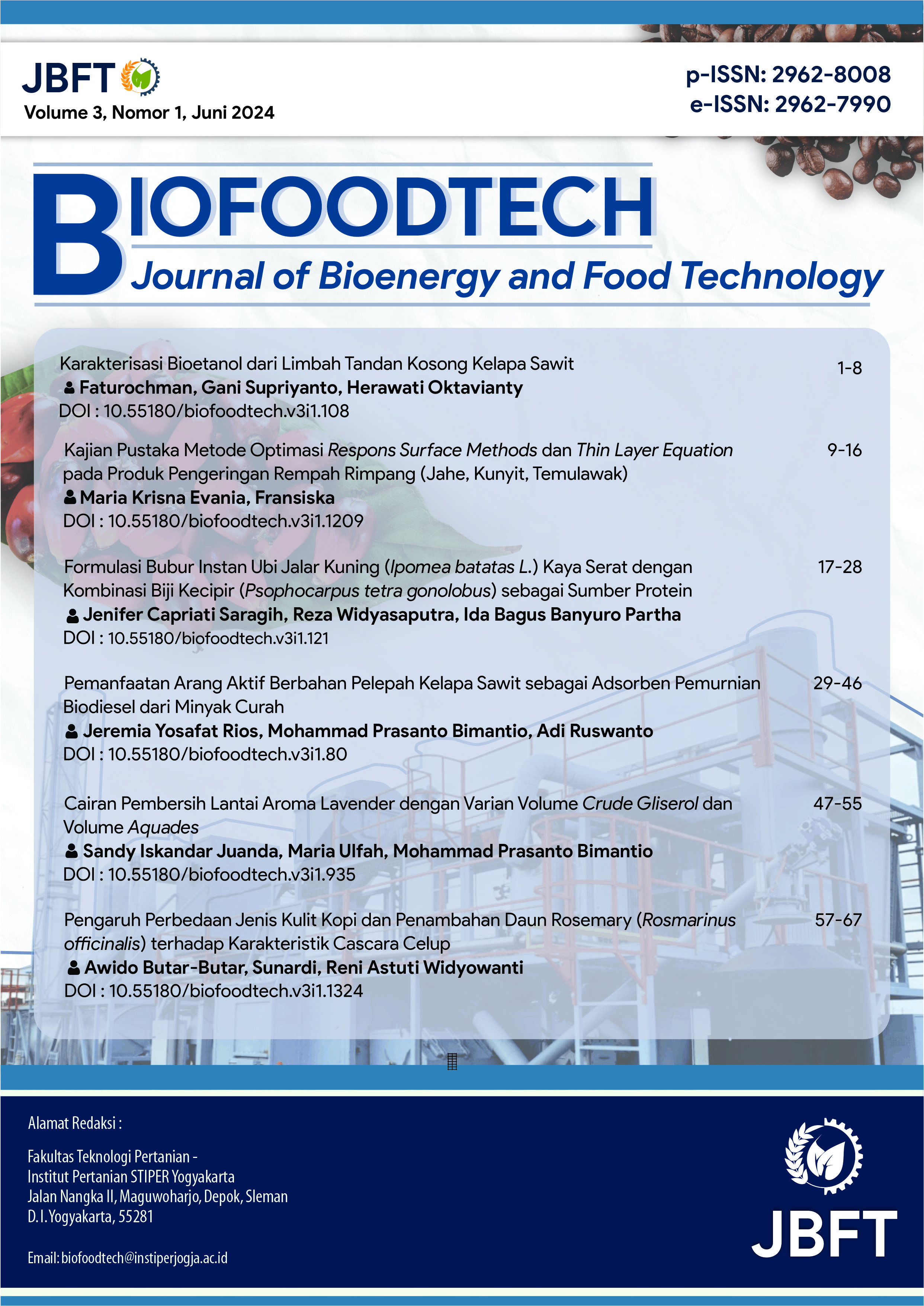Pemanfaatan Arang Aktif Berbahan Pelepah Kelapa Sawit sebagai Adsorben Pemurnian Biodiesel dari Minyak Curah
DOI:
https://doi.org/10.55180/biofoodtech.v3i1.803Kata Kunci:
Biodiesel, adsorb, activated charcoal, palm frondsAbstrak
The trans esterified biodiesel cannot be used immediately, because it still contains reaction residue and impurities. So it needs purification. One of them can use activated charcoal. The material used to make activated charcoal is palm fronds. Palm fronds contain lignocellulosic components, namely 25.08% cellulose, 24.06% hemicellulose and 18.46% lignin. This component can be applied as an adsorbent. The aim of the research was to determine the size of the activated charcoal and the length of time the adsorption of activated charcoal had an effect on biodiesel purification and to find out the best formulation from the ratio of the size of activated charcoal and the adsorption time to biodiesel purification. This study used a complete block design (RBL), with two factors, namely the ratio of activated charcoal size (A) and adsorption time (B) carried out 2 repetitions. For the average results of the analysis of this study, the acid number was 7.66 mg-KOH/gr, the saponification number was 251.75 mg KOH/gr, the density was 0.93 g/ml, the viscosity was 31.64 cst, the chromameter colour was 3.43, the impurities content was 4 .4% and GC-MS contained the most compounds, namely 9-Octadecenoic acid (Z)-, methyl ester with a surface area of 42.80% and a retention time of 27.292 minutes. The conclusion of the study is that the size comparison of activated charcoal and adsorption time made from palm fronds can adsorb impurities in biodiesel.
Referensi
Ariyanto, E., Lestari, D. D., & Kharismadewi, D. (2021). Analisa Kemampuan dan Kinetika Adsorpsi Karbon Aktif dari Cangkang Ketapang terhadap Zat Warna Metil Oranye. Jurnal Dinamika Penelitian Industri, 32(2), 166–178. https://doi.org/10.28959/jdpi.v32i2.7028
Bimantio, M. P., Oktavianty, H., & Widyasaputra, R. (2020). The design of A Portable Fixed-Bed Composite Adsorber Column as a Biodiesel Purification Media with Packing Bed System. TEKNIK, 41(3), 253–260. https://doi.org/10.14710/teknik.v41i3.32661
Devita, L. (2015). BIODIESEL SEBAGAI BIOENERGI ALTERNATIF DAN PROSPEFTIF. Agrica Ekstensia, 9(2), 23–26.
Efendi, R., Faiz, H. A. N., & Firdaus, E. R. (2018). PEMBUATAN BIODIESEL MINYAK JELANTAH MENGGUNAKAN METODE ESTERIFIKASITRANSESTERIFIKASI BERDASARKAN JUMLAH PEMAKAIAN MINYAK JELANTAH. Prosiding Industrial Research Workshop and National Seminar, 9, 402–409. https://doi.org/10.35313/irwns.v9i0.1129
Hadiah, F., Meliasari, T., & Heryanto, H. (2020). Pemurnian Minyak Jelantah dengan Menggunakan Adsorben Serbuk Biji Kelor Tanpa Karbonisasi dan Bentonit. Jurnal Teknik Kimia, 26(1), Article 1. https://doi.org/10.36706/jtk.v26i1.92
Hakim, R., Wrasiati, L. P., & Arnata, I. W. (2021). Karakteristik Minyak Jelantah Hasil dari Proses Pemurnian dengan Ampas Tebu pada berbagai Variasi Suhu dan waktu Pengadukan. Jurnal Rekayasa dan Manajemen Agroindustri, 9(4), 427–438.
Hasni, H., Yani, S., Aladin, A., & Septiani, M. (2020). KESETIMBANGAN PROSES DESORPSI AMONIA DARI ARANG AKTIF HASIL PIROLISIS LIMBAH BIOMASSA. AL ULUM JURNAL SAINS DAN TEKNOLOGI, 5(2), 48. https://doi.org/10.31602/ajst.v5i2.2803
Imelda, D., Khanza, A., & Wulandari, D. (2019). Pengaruh Ukuran Partikel Dan Suhu Terhadap Penyerapan Logam Tembaga (Cu) Dengan Arang Aktif Dari Kulit Pisang Kepok (Musa Paradisiaca Formatypica). Jurnal Teknologi, 6(2), 107–118. https://doi.org/10.31479/jtek.v6i2.10
Muhdarina, M., Nurhayati, N., Pahlepi, Mhd. R., Pujiana, Z., & Bahri, S. (2020). Penyiapan Arang Aktif Pelepah Kelapa Sawit sebagai Adsorben Asam Lemak Bebas dari CPO (Crude Palm Oil). al-Kimiya, 7(1), 7–13. https://doi.org/10.15575/ak.v7i1.6497
Mukminin, A., Megawati, E., Warsa, I. K., Yuniarti, Y., Umaro, W. A., & Islamiati, D. (2022). Analisis Kandungan Biodiesel Hasil Reaksi Transesterifikasi Minyak Jelantah Berdasarkan Perbedaan Kosentrasi Katalis NaOH Menggunakan GC-MS. Sang Pencerah: Jurnal Ilmiah Universitas Muhammadiyah Buton, 8(1), 146–158. https://doi.org/10.35326/pencerah.v8i1.1897
Nurdiani, I., Suwardiyono, S., & Kurniasari, L. (2021). PENGARUH UKURAN PARTIKEL DAN WAKTU PERENDAMAN AMPAS TEBU PADA PENINGKATAN KUALITAS MINYAK JELANTAH. Jurnal Inovasi Teknik Kimia, 6(1). https://doi.org/10.31942/inteka.v6i1.4451
Ratno, R., & Mawarani, L. J. (2013). Pengaruh Ampas Tebu Sebagai Adsorbent Pada Proses Pretreatment Minyak Jelantah Terhadap Karakteristik Biodiesel [Journal:eArticle, Institut Teknologi Sepuluh Nopember]. Dalam Jurnal Teknik ITS (Vol. 2, Nomor 2, hlm. 153266). https://doi.org/10.12962/j23373539.v2i2.4882
Robiah, R. (2019). REGENERASI MINYAK GORENG BEKAS SEBAGAI BAHAN BAKU BIODIESEL MENGGUNAKAN AMPAS TEBU SEBAGAI ADSORBEN. Jurnal Distilasi, 3(1), Article 1. https://doi.org/10.32502/jd.v3i1.1882
Sholikhah, H. I., Putri, H. R., & Inayati, I. (2021). Pengaruh Konsentrasi Aktivator Asam Fosfat (H3PO4) pada Pembuatan Karbon Aktif dari Sabut Kelapa terhadap Adsorpsi Logam Kromium. Equilibrium Journal of Chemical Engineering, 5(1), Article 1. https://doi.org/10.20961/equilibrium.v5i1.53572
Sukmawati, P. D. (2017). Pengaruh Serbuk Kulit Batang Kayu Lawang (Cinnamomun cullilawan) terhadap Mortalitas KUMBANG BUBUK BERAS (Sitophylus oryzae L.). Sanitasi: Jurnal Kesehatan Lingkungan, 8(4).
Syauqiah, I., Kusuma, F. I., & Mardiana, M. (2020). ADSORPTION OF Zn AND Pb METAL IN PRINTING WASTE OF PT. GRAFIKA WANGI KALIMANTAN USING CORN COBS CHARCOAL AS ADSORBENT. Konversi, 9(1), Article 1. https://doi.org/10.20527/k.v9i1.9075
Tumanggor, A. Z., & Ayu, D. F. (2021). UKURAN PARTIKEL DAN WAKTU KONTAK KARBON AKTIF DARI KULIT SINGKONG TERHADAP MUTU MINYAK JELANTAH. Sagu, 19(2), Article 2. https://doi.org/10.31258/sagu.v19i2.7896
Udyani, K., & WUlandari, Y. (2014). AKTIVASI ZEOLIT ALAM UNTUK PENINGKATAN KEMAMPUAN SEBAGAI ADSORBEN PADA PEMURNIAN BIODIESEL. 512–593.
Wijayanti, H., Nora, H., & Amelia, R. (2012). PEMANFAATAN ARANG AKTIF DARI SERBUK GERGAJI KAYU ULIN UNTUK MENINGKATKAN KUALITAS MINYAK GORENG BEKAS. Konversi, 1(1), Article 1. https://doi.org/10.20527/k.v1i1.106
Yamliha, A., Dwiargo, B., & Nugroho, W. A. (2013). PENGARUH UKURAN ZEOLITE TERHADAP PENYERAPAN KARBONDIOKSIDA (CO2) PADA ALIRAN BIOGAS. Jurnal Bioproses Komoditas Tropis, 1(2), Article 2.
Unduhan
Diterbitkan
Cara Mengutip
Terbitan
Bagian
Citation Check
Lisensi
Hak Cipta (c) 2024 BIOFOODTECH : Journal of Bioenergy and Food Technology

Artikel ini berlisensiCreative Commons Attribution-NonCommercial-ShareAlike 4.0 International License.











